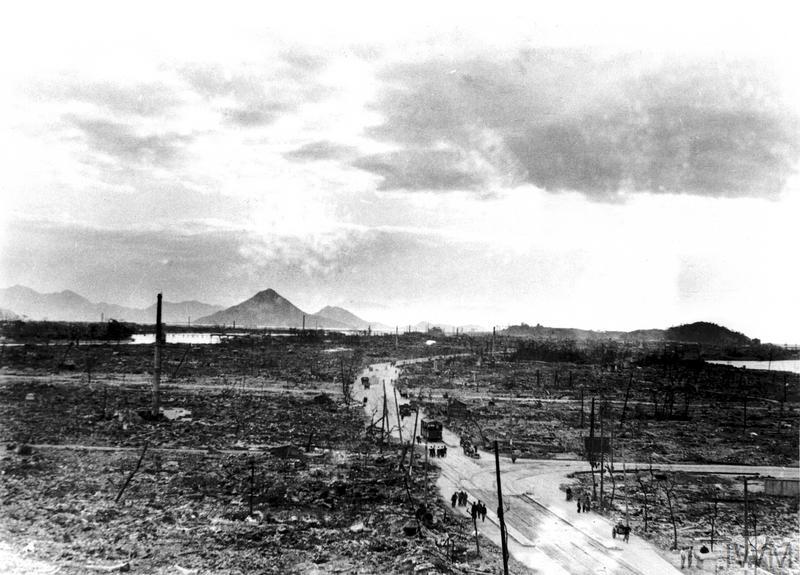On 9 August 1945, an atomic bomb was dropped on the Japanese city of Nagasaki. It followed the use of such a weapon on Hiroshima days earlier. Voices of War brings together first-hand accounts of what happened in Nagasaki, taken from IWM’s extensive sound archive and the archives of the Atomic Heritage Foundation.
"I remember saying to the Japanese ‘what have we done to you?’ The tears rolled down his eyes and he said, ‘what have we done to each other?’" - Sidney Lawrence, British POW.
Click on the audio player below to listen to our soundscape and reflect on the experiences of those who were there, from a Japanese schoolboy to British and Chinese prisoners of war.
Hear the voices of those who witnessed what happened in Nagasaki
“I think that no one else will ever experience the brutal tragedy that I witnessed at the age of eleven.”
“It was a hot summer’s day, pretty cloudless and the plane came over, and I looked up and I could see the glistening in the undercarriage in the fuselage, and there was certain reflections. Now to my knowledge that said to me, “Oh, they’ve opened the bomb door and I’ve caught the reflection in the sun.” And I stood looking at that plane and quite suddenly there was the most vivid, most awful flash, a terrible booming noise and a feeling of hot wind and air.”
“A whiteish hue that shook across the dune. Then came a roar that seemed to shake the whole house. After a few minutes the falling debris became more infrequent. All voices of people in the neighbourhood screaming and crying. At nine years I lifted my head up and looked around to find everything completely changed. The walls had come crumbling down, the furniture scattered all about, the roof had been blown off as well and we could see the sky.”
“And then the mushroom cloud, which seemed to get bigger and bigger and seemed to be blotting out the sun.”
“After a while all of us rushed to the far end of the dock. There we could see the port of Nagasaki wrapped in flames. It looked as if a giant roller had been over Nagasaki port.”
“There were trees which on one side were dead white and the other side was intact. All with its foliage. I remember crossing a little tiny bridge and there were shadows in the concrete of people. Shadows actually emblazoned in the concrete.”
“There are many dead bodies among the debris (inaudible). There were many dead bodies floating in the river as well.”
“Burns accounted for most of the cases. A woman I saw had a kimono of a flowered pattern in light and dark colours and this flowered pattern was faithfully reproduced on the skin of her back below.”
“When I heard about the atomic bomb, I was so astonished. I wondered if American people really (inaudible).”
“I remember saying to the Japanese, “What have we done to you?” The tears all down his eyes and he said, “What have we done to each other?” And from that moment, I felt at one with them.”
Who am I listening to?
-
Geoffrey Sherring
Served as civilian radio operator with the Merchant Navy in Atlantic. After his ship was sunk in 1942 , he was captured and became a prisoner of war. At the time of the atomic bomb dropped on Nagasaki, he was being held in Fukuoka No 14 camp, on the edge of the city.
-
A C I Belchen
A Malayan Chinese prisoner of war, held in a camp on the edge of Nagasaki.
-
Sidney Lawrence
Born in June 1917, he served during the Second World War as a British aircraftman with No. 36 Squadron RAF in the Dutch East Indies. He was captured on Java in March 1942. In November of that year he was transported to Japan and spent the rest of the war in prisoner of war camps, finally being held in Fukuoka camp No 14 at Nagasaki from January 1945 onwards. He was there on a working party when the atomic bomb was dropped on 9 August.
-
Hisatsune Sakomizu
Worked as a civilian government official in Japan throughout the war, ultimately serving as Chief Cabinet Secretary in Tokyo at the time of the atomic bombs being dropped.
Towards the end of the war he was ordered by Prime Minister Suzuki to investigate and analyse the economic condition of Japan, and to provide a written confidential report. Sakomizu found that Japan‘s resources were rapidly decreasing, and that Japan would be unable to continue fighting the war for more than a few months. After the conflict, he became a member of the House of Representatives and then joined the Liberal Democratic Party.
-
Yoshiro Yamawaki
Yoshiro was 11 years old when the atomic bomb was dropped on Nagasaki, Japan on 9 August 1945. His father was instantly killed, while Yoshiro and his twin brother, who were 2.2 kilometres away from the hypocentre, survived. Today, Yamawaki shares his testimony widely and serves as a strong advocate for the elimination of nuclear weapons. In 2010 the Japanese Ministry of Foreign Affairs appointed him as a Special Communicator for a World without Nuclear Weapons.
Clip courtesy of Atomic Heritage Foundation.











